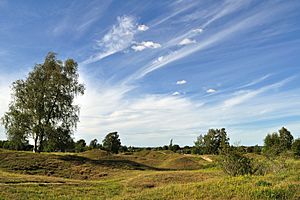- This page was last modified on 17 October 2025, at 10:18. Suggest an edit.
Barnack Hills & Holes National Nature Reserve facts for kids
| Site of Special Scientific Interest | |
 |
|
| Area of Search | Cambridgeshire |
|---|---|
| Interest | Biological |
| Area | 23.3 hectares |
| Notification | 1986 |
| Location map | Magic Map |
Barnack Hills & Holes is a very special place for nature in Barnack, Cambridgeshire. It covers about 23 hectares, which is like 46 football fields! It's known as a Site of Special Scientific Interest (SSSI) and also a national nature reserve. This means it's one of the most important places in the UK for wildlife.
Contents
What Makes Barnack Hills & Holes Special?
Barnack Hills & Holes is famous for its unique landscape and amazing plants. It's a "Nature Conservation Review site, Grade I," which means it's super important for protecting nature. In 2002, it became a Special Area of Conservation. This helps protect its beautiful grassland that is full of orchids. It's part of a big network called Natura 2000 across Europe.
A Landscape Made by People and Nature
The unusual "hills and holes" shape of the land was created a long time ago. People used to quarry, or dig out, limestone here. This stone was called "Barnack Rag." The Romans started digging for it over 1,500 years ago!
The stone was very valuable for building. It was used to build famous places like Peterborough and Ely Cathedrals. By the year 1500, most of the useful stone was gone. The bare piles of limestone slowly became covered by a rich carpet of wild flowers.
How the Stone Was Formed
The limestone itself is incredibly old. It formed during the Jurassic period, about 150 million years ago. Back then, this area was covered by a warm, shallow sea. Billions of tiny sea creatures lived and died there. Their remains slowly turned into the limestone we see today.
Amazing Wildlife at Barnack
Barnack Hills & Holes is home to many different kinds of wildlife. Its rich plant life supports lots of insects. You can even find some species here that are rare in the rest of the country.
Why Sheep are Important for the Plants
To keep the special limestone grasslands healthy, sheep are used for grazing. In the autumn, up to 300 sheep come to Barnack. They eat the summer growth of leaves, stalks, and grass.
Without the sheep, a thick layer of dead plants would build up. This would stop the rarer, lime-loving plants from growing. The sheep help keep the balance, allowing the beautiful wild flowers to thrive.
